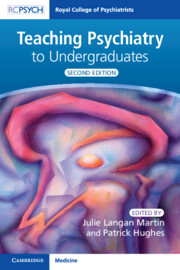Book contents
- Teaching Psychiatry to Undergraduates
- Teaching Psychiatry to Undergraduates
- Copyright page
- Contents
- Contributors
- Section 1 Principles of Medical Education
- Chapter 1.1 The Teacher
- Chapter 1.2 The Curriculum
- Chapter 1.3 Knowledge, Skills and Attitudes
- Chapter 1.4 The Learner
- Section 2 The Undergraduate Psychiatry Curriculum: Planning and Delivery
- Section 3 Clinical Placements in Psychiatry
- Section 4 Formal Teaching
- Section 5 Materials Development
- Section 6 Gathering feedback and quality improvement
- Section 7 Student Welfare
- Section 8 Developing as a medical educator
- Index
- References
Chapter 1.1 - The Teacher
from Section 1 - Principles of Medical Education
Published online by Cambridge University Press: 12 October 2022
- Teaching Psychiatry to Undergraduates
- Teaching Psychiatry to Undergraduates
- Copyright page
- Contents
- Contributors
- Section 1 Principles of Medical Education
- Chapter 1.1 The Teacher
- Chapter 1.2 The Curriculum
- Chapter 1.3 Knowledge, Skills and Attitudes
- Chapter 1.4 The Learner
- Section 2 The Undergraduate Psychiatry Curriculum: Planning and Delivery
- Section 3 Clinical Placements in Psychiatry
- Section 4 Formal Teaching
- Section 5 Materials Development
- Section 6 Gathering feedback and quality improvement
- Section 7 Student Welfare
- Section 8 Developing as a medical educator
- Index
- References
Summary
This chapter introduces the role of The Teacher within medical education and considers how this has changed in recent years. There is reflection on what it means ‘to teach’, as well as the importance of attitudes and role-modelling. The Hidden Curriculum is considered, with discussion of why it is important and how it can be influenced by the medical educator. This chapter also acknowledges the peculiarities of teaching psychiatry, and how this can be a rich vehicle for teaching values and attitudes – directly through the content, and indirectly through the hidden curriculum.
- Type
- Chapter
- Information
- Teaching Psychiatry to Undergraduates , pp. 1 - 5Publisher: Cambridge University PressPrint publication year: 2022

